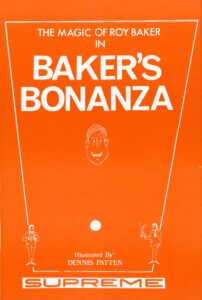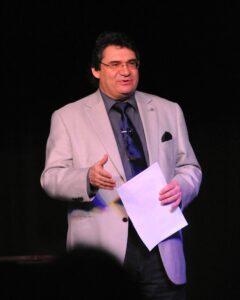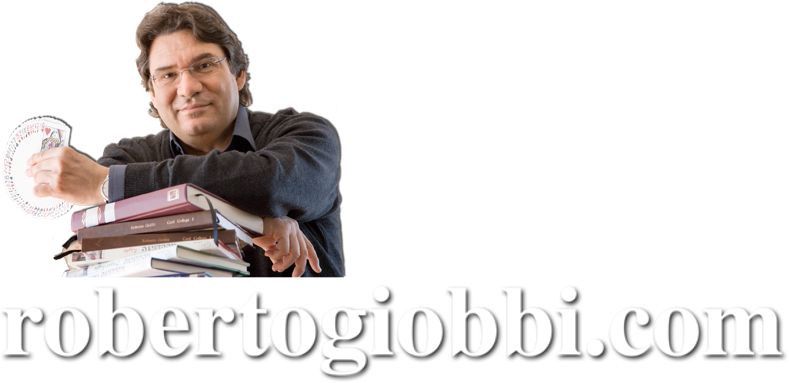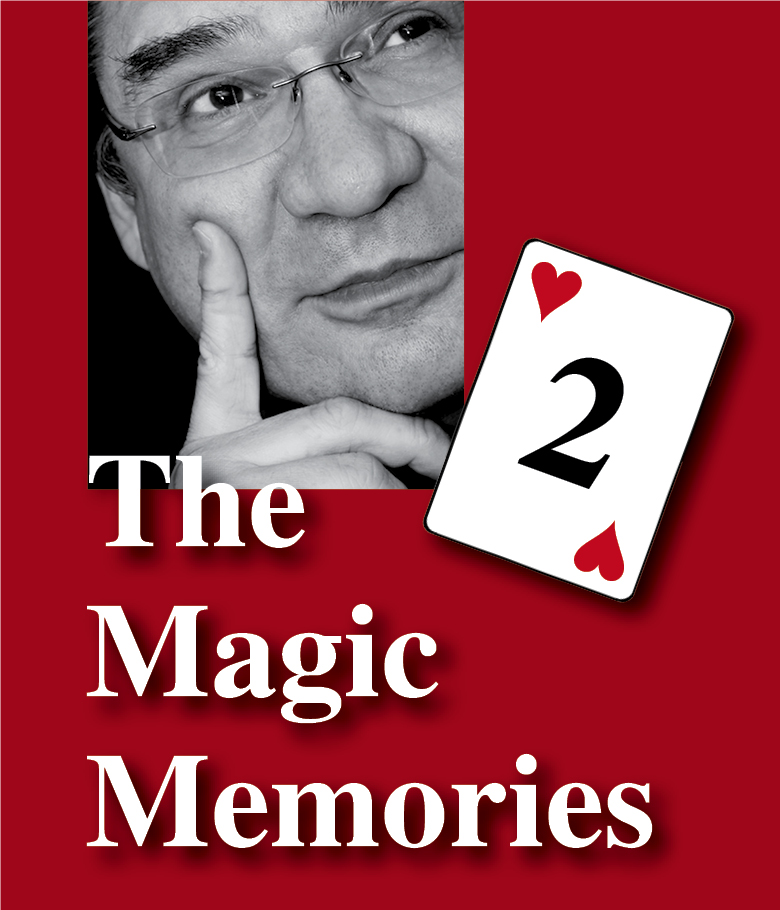
Hello everyone!
Today’s topics are: Addenda to Revelations and Productions; Another Look at PATEO; Lengthy explanations; The missing link – table cloth.
These are The Magic Memories 139, gone online Sunday, August 27th, 2023, at 0:07h sharp.
All The Magic Memories from 2021, 2022, including the Magic Advent Calendar from 2020, can be found HERE.
Addenda to Revelations and Productions
In last week’s blog I discussed quick revelations and productions of chosen cards. Michele Isenburg from Milan, Italy, wrote in and took my advice to heart to take one book from his library and look it through with focus on quick revelations. Here is what Michele came up with:
From my library, I took out a copy of Deck-Sterity by Harry Lorayne (Robbins E-Z Magic, 2nd edition), who is quite famous for his “quickies” 😊.
Here a list of some of his effects where a card or more cards are revealed in a magical way:
- The Flip over locator (page 20). As Harry writes, this is a cute quickie to reveal 3 selected cards
- New-Fangled Color Change (page 35). More a color change but can be used to reveal a selected card
- Outrageous revelation (Page 40). Quite bold, I haven’t tried in front of lay audience
- Trampoline (page 138). A flourish to reveal a selected card
- Flying Aces (page 140). Also this is a flourish type of revelation for one or more cards
Nice to go back to the classics and rediscover some good effects.
Another Look at PATEO
As a youngster I had the pleasure of briefly meeting Roy Baker (1921 – 2006) at an early British magic convention through Fred Castle (1909 – 1997), who kindly introduced me to him. I never saw Baker perform, but read several of his publications, and he certainly had some excellent ideas. He might be best known for a forcing method called PATEO.
The PATEO Force (Point At Two Eliminate One) is a simple, straightforward and versatile sure-fire force, which can be learned by anyone, and works particularly well for a limited number of objects.
Application Examples:
- On the face of blank cards are the logos of soccer teams: “You decide which team wins/loses.”
- Bob Neale’s “Soul Survivor” (Magic and Meaning, p. 133). 7 cards: 6 court cards, 1 Ace of Spades (the Plague).
- Wine bottles in brown paper bags – spectator chooses wine that fits course served. Other bottles could be revealed as being vinegar bottles, or one white wine and the rest red wines, etc. (Kostya Kimlat).
The original description is in Miller, Hugh, Baker’s Bonanza (Unique 1969, Supreme 1972), “Name Your Card”, p. 38.

Too many performers, especially beginners, fall in love with PATEO because it is so simple and easy, and that’s precisely the problem: The weakness of the method, if used on its own – that’s how many use it – is that some spectators are able to reconstruct it once the effect occurs. If you don’t believe this, you are fooling yourself. (Generally speaking, any linear procedure that leads to a prediction is problematic.)
Still, the method is indeed elegant and tempting. The solution of its deceptive use is to combine it with other principles.
Look at Baker’s original way of using the force in the attached PDF. As far as I could find out, the book is out of print, but obtainable as an e-book from lybrary.com, so I took the liberty of extracting just the description of this one trick for your perusal (CLICK HERE).
Notice the context into which the PATEO Force is put, combining several methods of apparently random selection – this makes for good deception.
A few comments, if I may: To speed up the dealing of the seven packets, you could quickly reverse count the top seven cards into the right hand, set the packet on the table, and then say you’ll speed this up, and now simply push over small packets of cards, placing another six packets on the table – there are now a total of seven packets on the table. Proceed as per the Baker routine.
As for how to manage and handle the PATEO: Notice the use of the two hands each placed above a packet (good!).
Instead of the lengthy spelling procedure, the Down-under Deal could be used, “It’s not this one, maybe this one, this one not for sure, that might be the one, this one is out, not so sure about this one… etc..
Lengthy Explanations
A while ago I received the following email from Don Gruenweller:
“I am just getting started with card magic. I have purchased a few other videos, but yours are by far and away the best. I appreciate all the extra little bits of advice about what to do and what not to do that you add along with your explanation of the main feature of each segment.”
The price to pay is that my texts are lengthy, and the video explanations, too.
Occasionally, this has been criticized.

This reminds me: While in Rome (see The Magic Memories 117) my friend Luca d’Agostini, who attended both my Masterclass on “Deck Switches” and my lecture on the next day, made a remark that humbled me, and I admit it reframed a doubt I had about my detailed explanations.
He said, “Your detailed explanations make us see and understand the beauty hidden beneath the surface of a performance piece, and thus allow us to deeply appreciate how ingenious and subtle such a pieces is.”
I admit that this touched me and made me think.
I thought of a guided tour in an art museum: If you look at a painting you might intuitively like it, but when an expert tells you the whats and whys of it, by putting the work in a historical and cultural context, maybe even giving biographical information about the painter, discussing technical details, then the appreciation gains an entirely new dimension.
And yes, this is what I have been trying to do with magic technique, tricks and theories, but I never looked at it that way. So, thank you to Don and Luca.
One more thing, if I may, namely the question: Are long texts or short ones better?
My answer: After now exactly fifty years in magic – I started at age fourteen – I believe that a good mix is best, in various proportions, depending on your learning style and on what phase you are in your growth (magic and life).
Let’s just look at trick explanations: I have no doubt that lengthy texts, such as those by Ascanio, Tamariz, or mine, will open doors and windows to areas you didn’t even imagine existed. If the text then details those areas, you will learn poylvalent concepts that will help you improve your whole magic, not just teach you a specific trick.
Such texts are of immense importance as they teach you the essence of magic.
On the other hand, short texts allow you to quickly obtain information, accumulate ideas, and more often than not can trigger ideas of your own (Secret Agenda and Hidden Agenda are “trigger books”). This brings to mind what André Gide, French Nobel Prize in literature, once said, “I like the unfinished, as I can still complete it.”
Good examples of mostly “unfinished” explanations can be found in Frank Garcia’s Million Dollar Card Secrets and Super Subtle Card Miracles, as well as in The Encyclopedia of Card Tricks. The latter is an excellent example of this genre, as not only are the descriptions terse, to say the least, there are also quite a bit of not-so-good tricks, and you have to dive for pearls. Open a note in your notebook and make a list of this type of book – how many can you list?
The Missing Link – The Table Cloth
To end today’s magical peregrination here is something that will surprise you, and maybe make you smile – CLICK HERE.
Wish you all an excellent week!
Roberto Giobbi


Roberto, the Hugh Miller is a gem. Thanks for sharing that here. I hope to have a couple of things to send you for your thoughts.